Miikka Silfverberg
The University of British Columbia
Multiple Sources are Better Than One: Incorporating External Knowledge in Low-Resource Glossing
Jun 16, 2024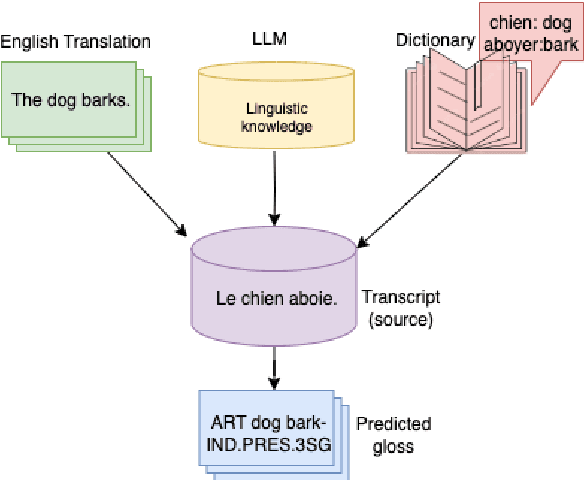


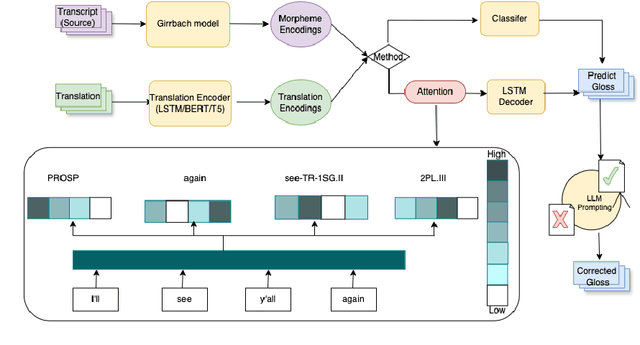
Abstract:In this paper, we address the data scarcity problem in automatic data-driven glossing for low-resource languages by coordinating multiple sources of linguistic expertise. We supplement models with translations at both the token and sentence level as well as leverage the extensive linguistic capability of modern LLMs. Our enhancements lead to an average absolute improvement of 5%-points in word-level accuracy over the previous state of the art on a typologically diverse dataset spanning six low-resource languages. The improvements are particularly noticeable for the lowest-resourced language Gitksan, where we achieve a 10%-point improvement. Furthermore, in a simulated ultra-low resource setting for the same six languages, training on fewer than 100 glossed sentences, we establish an average 10%-point improvement in word-level accuracy over the previous state-of-the-art system.
Embedded Translations for Low-resource Automated Glossing
Mar 13, 2024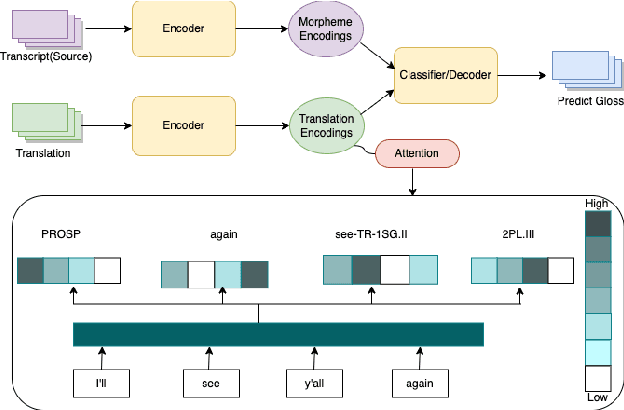

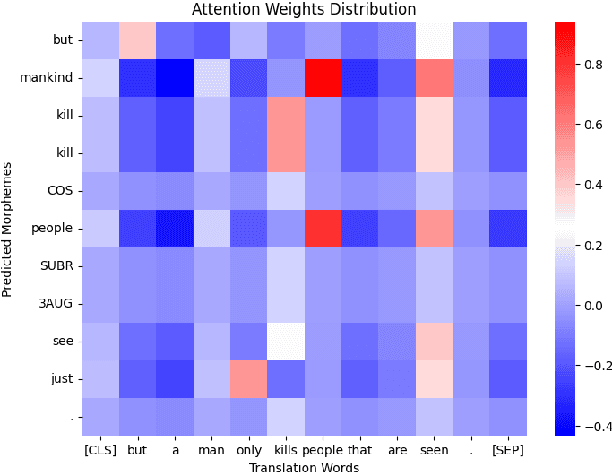
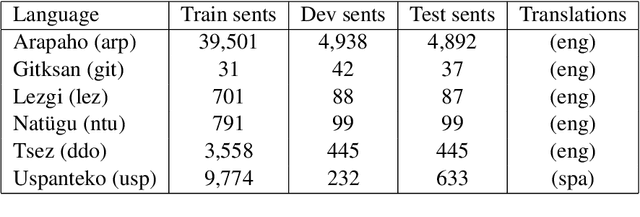
Abstract:We investigate automatic interlinear glossing in low-resource settings. We augment a hard-attentional neural model with embedded translation information extracted from interlinear glossed text. After encoding these translations using large language models, specifically BERT and T5, we introduce a character-level decoder for generating glossed output. Aided by these enhancements, our model demonstrates an average improvement of 3.97\%-points over the previous state of the art on datasets from the SIGMORPHON 2023 Shared Task on Interlinear Glossing. In a simulated ultra low-resource setting, trained on as few as 100 sentences, our system achieves an average 9.78\%-point improvement over the plain hard-attentional baseline. These results highlight the critical role of translation information in boosting the system's performance, especially in processing and interpreting modest data sources. Our findings suggest a promising avenue for the documentation and preservation of languages, with our experiments on shared task datasets indicating significant advancements over the existing state of the art.
An Investigation of Noise in Morphological Inflection
May 26, 2023
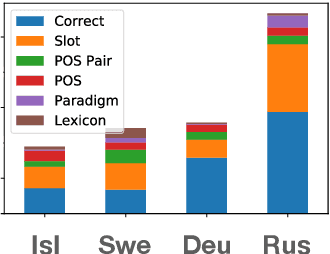
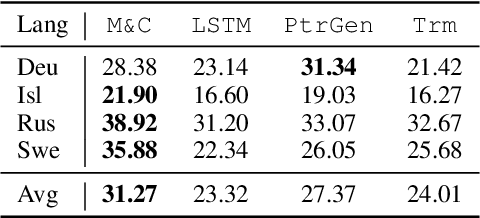
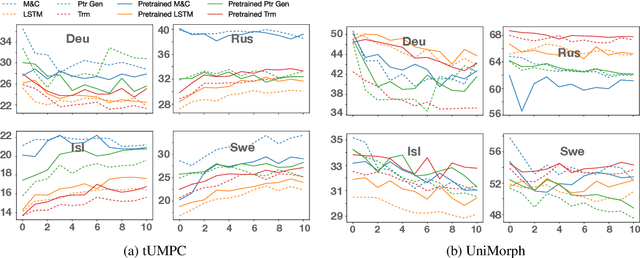
Abstract:With a growing focus on morphological inflection systems for languages where high-quality data is scarce, training data noise is a serious but so far largely ignored concern. We aim at closing this gap by investigating the types of noise encountered within a pipeline for truly unsupervised morphological paradigm completion and its impact on morphological inflection systems: First, we propose an error taxonomy and annotation pipeline for inflection training data. Then, we compare the effect of different types of noise on multiple state-of-the-art inflection models. Finally, we propose a novel character-level masked language modeling (CMLM) pretraining objective and explore its impact on the models' resistance to noise. Our experiments show that various architectures are impacted differently by separate types of noise, but encoder-decoders tend to be more robust to noise than models trained with a copy bias. CMLM pretraining helps transformers, but has lower impact on LSTMs.
Understanding compositional data augmentation in automatic morphological inflection
May 23, 2023Abstract:Data augmentation techniques are widely used in low-resource automatic morphological inflection to address the issue of data sparsity. However, the full implications of these techniques remain poorly understood. In this study, we aim to shed light on the theoretical aspects of the data augmentation strategy StemCorrupt, a method that generates synthetic examples by randomly substituting stem characters in existing gold standard training examples. Our analysis uncovers that StemCorrupt brings about fundamental changes in the underlying data distribution, revealing inherent compositional concatenative structure. To complement our theoretical analysis, we investigate the data-efficiency of StemCorrupt. Through evaluation across a diverse set of seven typologically distinct languages, we demonstrate that selecting a subset of datapoints with both high diversity and high predictive uncertainty significantly enhances the data-efficiency of StemCorrupt compared to competitive baselines. Furthermore, we explore the impact of typological features on the choice of augmentation strategy and find that languages incorporating non-concatenativity, such as morphonological alternations, derive less benefit from synthetic examples with high predictive uncertainty. We attribute this effect to phonotactic violations induced by StemCorrupt, emphasizing the need for further research to ensure optimal performance across the entire spectrum of natural language morphology.
Yet Another Format of Universal Dependencies for Korean
Sep 20, 2022

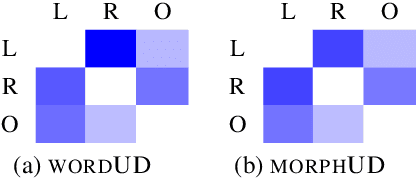
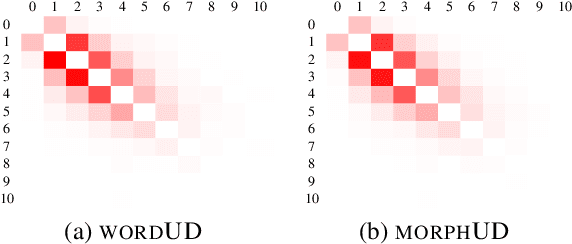
Abstract:In this study, we propose a morpheme-based scheme for Korean dependency parsing and adopt the proposed scheme to Universal Dependencies. We present the linguistic rationale that illustrates the motivation and the necessity of adopting the morpheme-based format, and develop scripts that convert between the original format used by Universal Dependencies and the proposed morpheme-based format automatically. The effectiveness of the proposed format for Korean dependency parsing is then testified by both statistical and neural models, including UDPipe and Stanza, with our carefully constructed morpheme-based word embedding for Korean. morphUD outperforms parsing results for all Korean UD treebanks, and we also present detailed error analyses.
UniMorph 4.0: Universal Morphology
May 10, 2022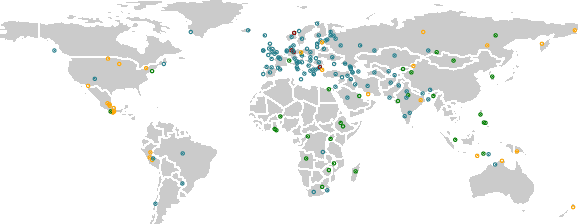

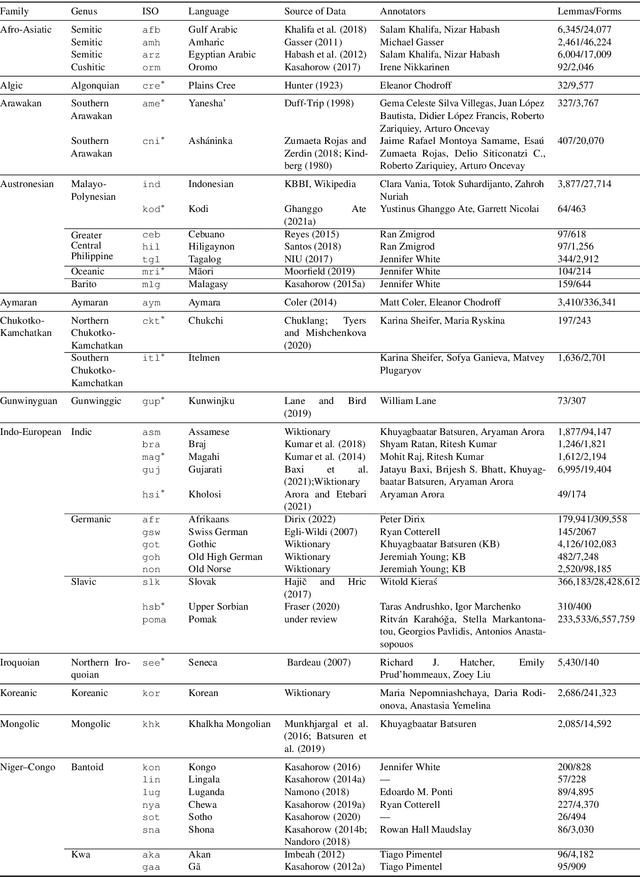
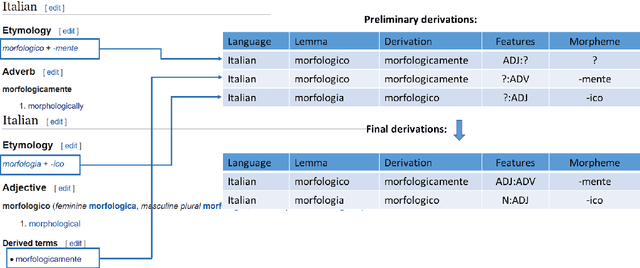
Abstract:The Universal Morphology (UniMorph) project is a collaborative effort providing broad-coverage instantiated normalized morphological inflection tables for hundreds of diverse world languages. The project comprises two major thrusts: a language-independent feature schema for rich morphological annotation and a type-level resource of annotated data in diverse languages realizing that schema. This paper presents the expansions and improvements made on several fronts over the last couple of years (since McCarthy et al. (2020)). Collaborative efforts by numerous linguists have added 67 new languages, including 30 endangered languages. We have implemented several improvements to the extraction pipeline to tackle some issues, e.g. missing gender and macron information. We have also amended the schema to use a hierarchical structure that is needed for morphological phenomena like multiple-argument agreement and case stacking, while adding some missing morphological features to make the schema more inclusive. In light of the last UniMorph release, we also augmented the database with morpheme segmentation for 16 languages. Lastly, this new release makes a push towards inclusion of derivational morphology in UniMorph by enriching the data and annotation schema with instances representing derivational processes from MorphyNet.
Dim Wihl Gat Tun: The Case for Linguistic Expertise in NLP for Underdocumented Languages
Mar 17, 2022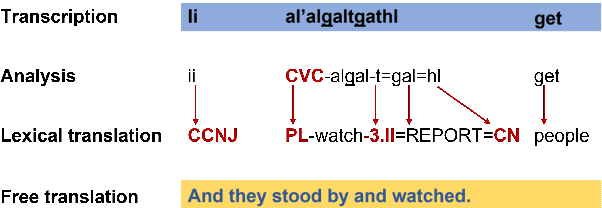
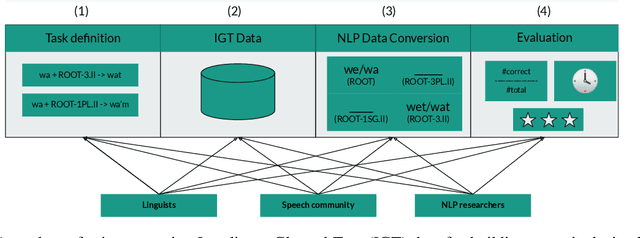
Abstract:Recent progress in NLP is driven by pretrained models leveraging massive datasets and has predominantly benefited the world's political and economic superpowers. Technologically underserved languages are left behind because they lack such resources. Hundreds of underserved languages, nevertheless, have available data sources in the form of interlinear glossed text (IGT) from language documentation efforts. IGT remains underutilized in NLP work, perhaps because its annotations are only semi-structured and often language-specific. With this paper, we make the case that IGT data can be leveraged successfully provided that target language expertise is available. We specifically advocate for collaboration with documentary linguists. Our paper provides a roadmap for successful projects utilizing IGT data: (1) It is essential to define which NLP tasks can be accomplished with the given IGT data and how these will benefit the speech community. (2) Great care and target language expertise is required when converting the data into structured formats commonly employed in NLP. (3) Task-specific and user-specific evaluation can help to ascertain that the tools which are created benefit the target language speech community. We illustrate each step through a case study on developing a morphological reinflection system for the Tsimchianic language Gitksan.
Morphological Processing of Low-Resource Languages: Where We Are and What's Next
Mar 16, 2022

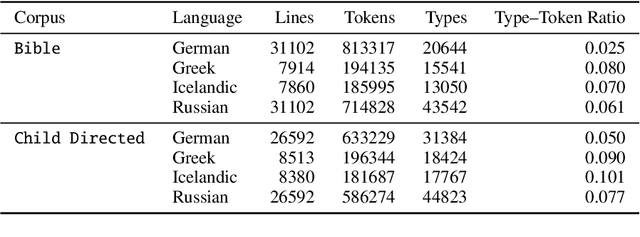

Abstract:Automatic morphological processing can aid downstream natural language processing applications, especially for low-resource languages, and assist language documentation efforts for endangered languages. Having long been multilingual, the field of computational morphology is increasingly moving towards approaches suitable for languages with minimal or no annotated resources. First, we survey recent developments in computational morphology with a focus on low-resource languages. Second, we argue that the field is ready to tackle the logical next challenge: understanding a language's morphology from raw text alone. We perform an empirical study on a truly unsupervised version of the paradigm completion task and show that, while existing state-of-the-art models bridged by two newly proposed models we devise perform reasonably, there is still much room for improvement. The stakes are high: solving this task will increase the language coverage of morphological resources by a number of magnitudes.
Translating the Unseen? Yoruba-English MT in Low-Resource, Morphologically-Unmarked Settings
Apr 06, 2021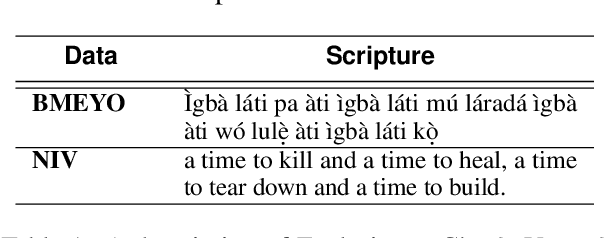
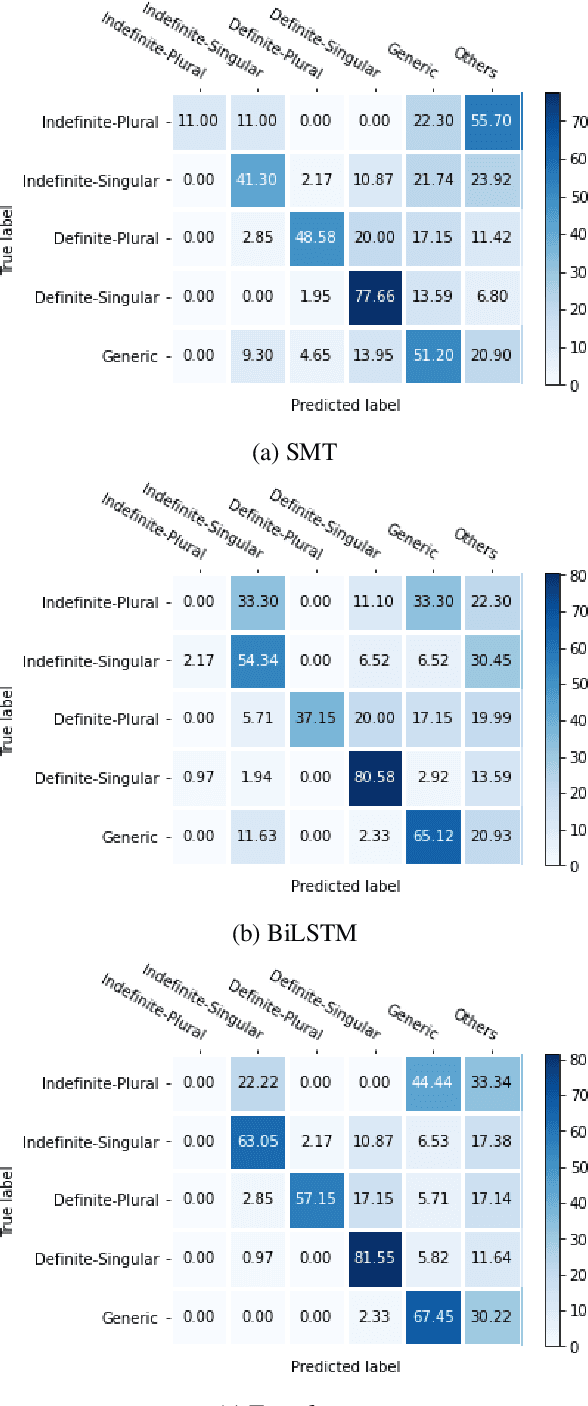

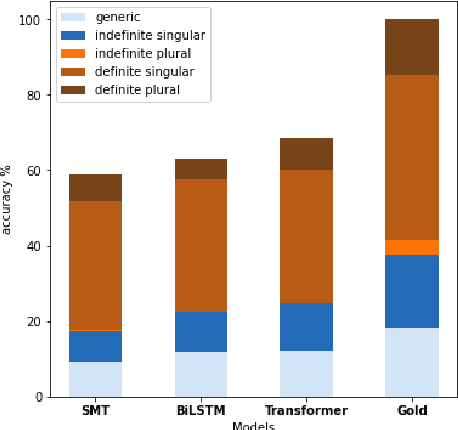
Abstract:Translating between languages where certain features are marked morphologically in one but absent or marked contextually in the other is an important test case for machine translation. When translating into English which marks (in)definiteness morphologically, from Yor\`ub\'a which uses bare nouns but marks these features contextually, ambiguities arise. In this work, we perform fine-grained analysis on how an SMT system compares with two NMT systems (BiLSTM and Transformer) when translating bare nouns in Yor\`ub\'a into English. We investigate how the systems what extent they identify BNs, correctly translate them, and compare with human translation patterns. We also analyze the type of errors each model makes and provide a linguistic description of these errors. We glean insights for evaluating model performance in low-resource settings. In translating bare nouns, our results show the transformer model outperforms the SMT and BiLSTM models for 4 categories, the BiLSTM outperforms the SMT model for 3 categories while the SMT outperforms the NMT models for 1 category.
Do RNN States Encode Abstract Phonological Processes?
Apr 01, 2021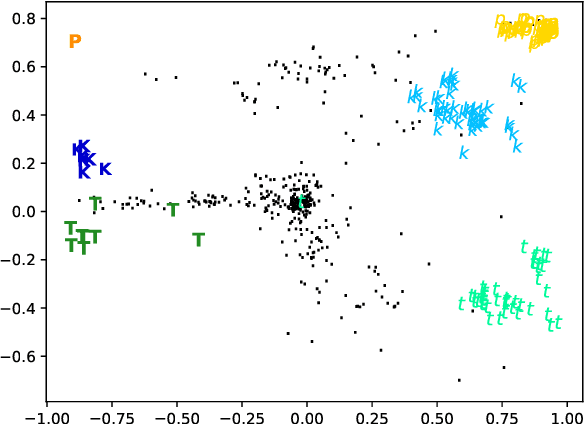
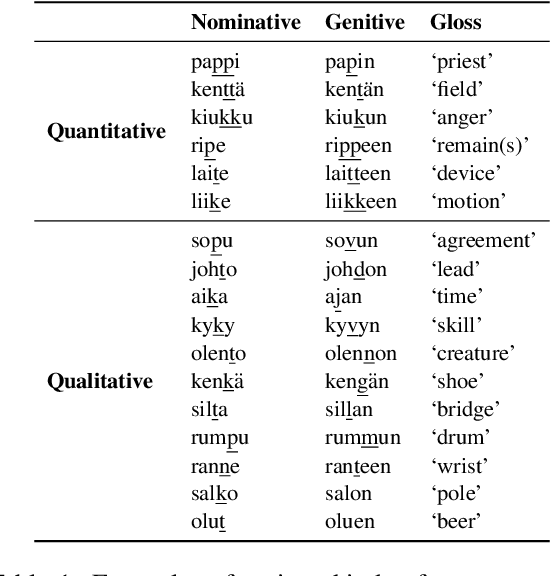
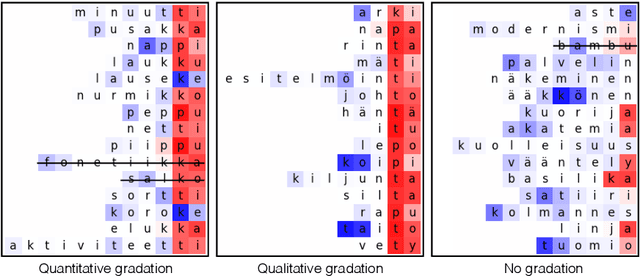
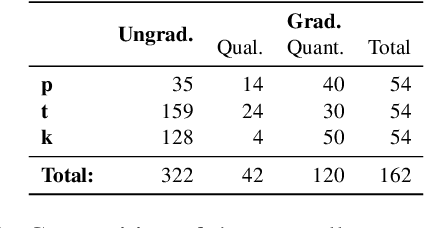
Abstract:Sequence-to-sequence models have delivered impressive results in word formation tasks such as morphological inflection, often learning to model subtle morphophonological details with limited training data. Despite the performance, the opacity of neural models makes it difficult to determine whether complex generalizations are learned, or whether a kind of separate rote memorization of each morphophonological process takes place. To investigate whether complex alternations are simply memorized or whether there is some level of generalization across related sound changes in a sequence-to-sequence model, we perform several experiments on Finnish consonant gradation -- a complex set of sound changes triggered in some words by certain suffixes. We find that our models often -- though not always -- encode 17 different consonant gradation processes in a handful of dimensions in the RNN. We also show that by scaling the activations in these dimensions we can control whether consonant gradation occurs and the direction of the gradation.
 Add to Chrome
Add to Chrome Add to Firefox
Add to Firefox Add to Edge
Add to Edge